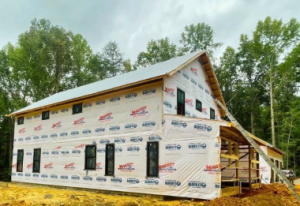In yesterday’s posting, I quoted Harris Hyman, an engineer from Portland, Oregon, who appears to know his stuff when it comes to preventing frost heave.
In a July 1994 article, in the Journal of Light Construction he listed some methods which don’t work to prevent frost heave:
 “Another method for dealing with frost involves wrapping posts with plastic, so that the ice slips when it heaves. I suspect that this will work for a year or two – maybe – but eventually the deterioration of the plastic will bring the whole dream to an end. It seems that filling postholes with uniformly graded 1-1/2-inch crushed stone might work a little better. However, I do admit never having worked with plastic wrap and look forward to hearing about your experience.”
“Another method for dealing with frost involves wrapping posts with plastic, so that the ice slips when it heaves. I suspect that this will work for a year or two – maybe – but eventually the deterioration of the plastic will bring the whole dream to an end. It seems that filling postholes with uniformly graded 1-1/2-inch crushed stone might work a little better. However, I do admit never having worked with plastic wrap and look forward to hearing about your experience.”
Personally, I’ve always wondered about the effectiveness of plastic sleeves in the resistance of frost uplift. The most commonly seen commercially available sleeves will certainly outlast any thin layer of plastic however.
“Another technique is using rigid foam insulation to protect walls. This is useful for heat retention, not for frost protection. It should be supplemented with a drain rock backfill.
The two worst methods for dealing with frost heaving are the heated foundation and the locking bar. I call the heated foundation “structural use of energy” – burning irreplaceable fuel, warming the soil around the building, to prevent frost damage and hold a building together. This is both extremely expensive over a long period of time and socially undesirable. Even though it cuts down on initial construction costs, it should not be encouraged.”
When we put up our building in South Dakota I asked our builder about frost heave, his answer lead me to understand him as a firm believer in heating a building up far enough to chase the frost out of the ground!
“The locking bar is a bit of foolishness that seems to keep appearing on construction sites. This is a cross-bar nailed or lag-screwed to a post, usually about 2 feet below grade. Apparently the builders think this helps hold the post down, but it is usually above the ice lens and actually helps lift the post.”
I’ve seen this and other similar methods – like rebar driven through the columns or a series of large diameter nails or lags driven into the posts. All of these are going to afford the same ability to frost heave the columns.
In the words of Harris Hyman, “So the best way to beat frost is just to let it freeze – but get rid of the water first.”
I’ve written extensively on frost heave in the past. For more information, hop in the “Wayback” machine and check out: https://news.yahoo.com/first-person-snapshot-black-hills-blizzard-201300744.html







40×55 pole shed. North corner post raised 6 inches and
And each post alongside. Had outfit 5 years ago
Dig these same post and pounded them down
and nailed twox4 s on the bottom of each post.
Now they raised again. Looking for a permanent
solution. Any suggestions?
For an expert opinion – you should invest in a capable local Registered Geotechnical Engineer who can visit your site and make a detailed evaluation. Without seeing your building site, I can only make guesses – one is you have underground water flowing beneath your building in this area. Make sure your site is graded away from building for at least 10 feet at a 5% or greater downslope. Have a French Drain installed to divert water away from your building. Gutter downspouts should have extensions to discharge water runoff from your roof at least 10 feet away from building (and so water flows away). Second guess is it is very possible these columns do not extend well below frost line. The columns could be individually excavated – included going significantly below frost line, an uplift plate installed on column just above its bottom and then pouring concrete below column base and extending up columns at least a foot. This concrete pour should be formed so it is wider at base than top and then soils above the pour need to be adequately compacted.